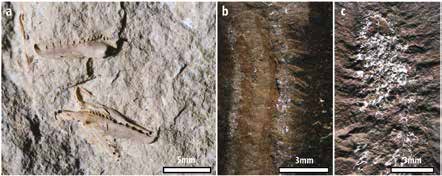Introduction
Annelids are an ancient animal phylum with a fossil record that extends approximately 520 million years to the early Cambrian. During this time, annelids have evolved a multitude of body plans, feeding modes, ecologies and life histories. They occur in diverse ecosystems ranging from the deep sea to terrestrial soils, and fill niches from vagile predators to sessile filter feeders. Annelid body fossils are known from numerous Palaeozoic Lagerstätten and are preserved in various ways, including as carbonaceous compressions, pyritized remains and in iron carbonate concretions. Such fossils can preserve exquisite detail, including guts and muscles, and offer rare but important insights into annelid origins.
The oldest annelids are fossil polychaetes preserved as carbonaceous compressions from the early Cambrian Sirius Passet (Vinther et al. 2011) and Guanshan (Liu et al. 2015) biotas, and are not readily comparable with any extant groups. The oldest unequivocal crown group annelids are scolecodonts (Hints and Eriksson 2007), the jaws of eunicidan polychaetes, which are organic in composition and recoverable from sedimentary rocks by acid maceration. Despite their potential evolutionary significance, prior to this project there were no robust and taxonomically inclusive phylogenetic hypotheses for Palaeozoic fossil annelids, with analyses restricted to either few characters or single fossil taxa.

This research project sought to identify new fossil polychaetes from collections housed at the Royal Ontario Museum (ROM), including material from the Cambrian, Devonian and Carboniferous. During this research I identified new characters from known taxa from the Burgess Shale and Mazon Creek and from one new taxon from each of the Devonian of Ontario and Mazon Creek. Morphological observations derived from known taxa were incorporated into a novel character matrix for all annelids which was recently published in the Proceedings of the Royal Society B (Parry et al. 2016).
New annelid taxa
Exceptionally large scolecodonts from the Lower Eifelian (Lower-Middle Devonian) Kwataboahegan Formation, Rabbit (Askaskawayau) Ridge, Ontario, Canada were studied at the ROM. Unlike typical scolecodonts, these specimens are preserved on bedding planes and are readily visible to the naked eye, typically >10 mm long (Figure 1a). These specimens are comparable in size to the jaws of Eunice aphroditois (the ‘bobbit worm’), whose whole body can be >2 m long. Consequently, these are the largest fossil polychaete jaws known. Descriptions of the Eifelian specimens are currently in preparation in collaboration with Prof. Mats Eriksson (Lund University) and David Rudkin (ROM).
The ROM houses a substantial collection of concretions from Mazon Creek, the annelid portion of which has never been extensively studied. Currently, numerous polychaete taxa that span the diversity of the annelid crown group are described from this biota (Jones and Thompson 1977; Thompson and Johnson 1977; Thompson 1979; Hay 2002). One new taxon was identified as a possible member of the Chrysopetalidae, the earliest (and only) fossil record for this family. It possesses a dorsal covering of chaetae (Figure 1b) and a pair of anterior jaws (Figure 1c).
Annelid Phylogeny
Historical morphological and molecular phylogenies conflict over the identity of the earliest diverging annelid groups and the composition of the annelid crown group. Morphological trees place the unsegmented Echiura (spoon worms) and Sipuncula (peanut worms) outside of Annelida, and recover polychaetes with simple body plans (‘Scolecida’) as an early diverging clade or grade within annelids (Rouse and Fauchald 1997). Crucially, polychaetes are recovered as monophyletic with respect to the clitellates (earthworms, leeches and their close relatives). In contrast, molecular phylogenies place the unsegmented echiurans, sipunculans and clitellates within a paraphyletic grade of polychaetes (Struck et al. 2011). Incorporation of data from fossil annelids (particularly those from the Cambrian, e.g. Parry et al. 2015) repolarizes morphological characters, placing echiurans and clitellates (but not sipunculans) within polychaetes, rendering them paraphyletic (Figure 2). This result is stable across optimality criteria and their implementations (e.g. maximum parsimony, maximum likelihood, Bayesian inference) (Parry, et al. 2016).
Acknowledgements
I thank the Palaeontological Association for Sylvester-Bradley Award PA-SB201404 that funded this research.
REFERENCES
- HAY, A.A. 2002. Flabelligerida from the Francis Creek shale of Illinois. Journal of Paleontology, 76, 764–766.
- HINTS, O. and ERIKSSON, M. 2007. Diversification and biogeography of scolecodont-bearing polychaetes in the Ordovician. Palaeogeography Palaeoclimatology Palaeoecology, 245, 95–114.
- JONES, D. and THOMPSON, I. 1977. Echiura from the Pennsylvanian Essex fauna of northern Illinois. Lethaia, 10, 317–325.
- LIU, J., OU, Q., HAN, J., LI, J., WU, Y., JIAO, G. and HE, T. 2015. Lower Cambrian polychaete from China sheds light on early annelid evolution. The Science of Nature, 102, 1–7.
- PARRY, L., VINTHER, J. and EDGECOMBE, G.D. 2015. Cambrian stem-group annelids and a metameric origin of the annelid head. Biology Letters, 11, 20150763.
- PARRY, L.A., EDGECOMBE, G.D., EIBYE-JACOBSEN, D. and VINTHER, J. 2016. The impact of fossil data on annelid phylogeny inferred from discrete morphological characters. 20161378. Proceedings of the Royal Society B, 283, 20161378.
- ROUSE, G.W. and FAUCHALD, K. 1997. Cladistics and polychaetes. Zoologica Scripta, 26, 139–204.
- STRUCK, T., PAUL, C., HILL, N., HARTMANN, S., HOSEL, C., KUBE, M., LIEB, B., MEYER, A., TIEDEMANN, R., PURSCHKE, G. and BLEIDORN, C. 2011. Phylogenomic analyses unravel annelid evolution. Nature, 471, 95–113.
- THOMPSON, I. 1979. Errant polychaetes (Annelida) from the Pennsylvanian Essex fauna of northern Illinois. Palaeontographica Abteilung A, 163, 169–199.
- THOMPSON, I. and JOHNSON, R.G. 1977. New fossil polychaete from Essex, Illinois. Field Museum of Natural History, Chicago. 34 pp.
- VINTHER, J., EIBYE-JACOBSEN, D. and HARPER, D.A. 2011. An Early Cambrian stem polychaete with pygidial cirri. Biology Letters, 7, 929–932.
